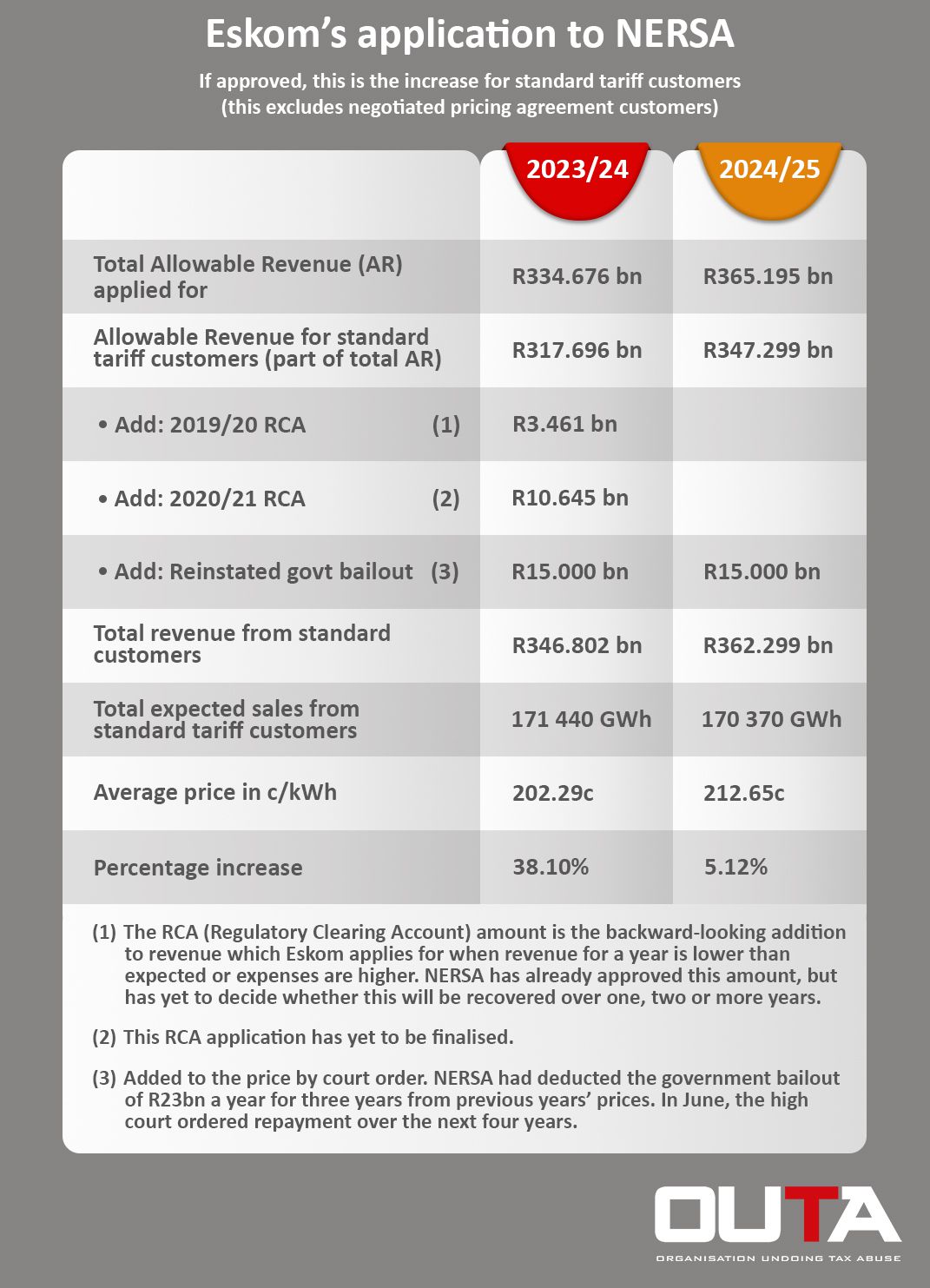Graphic: OUTA
OUTA calls on NERSA to limit Eskom’s 2023 increase to CPI
High coal costs, low energy availability, unexplained costs, an economy strangled by lack of electricity and consumers who struggle to pay the current price: OUTA believes this is not a basis for a huge electricity price hike.
As the country buckles under stage 6 loadshedding, Eskom is coming back to citizens of South Africa to ask for more money. It is outrageous that people are being asked to pay when services are not delivered: businesses, public services and households are being significantly disrupted by the now-routine loadshedding. Eskom seems to assume that electricity consumers are a captive audience from which it can demand money while failing to supply a service.
“OUTA calls on NERSA to grant a maximum of a consumer price index (CPI) tariff increase; if the economy is to recover from Covid, electricity needs to be kept to an affordable level in order to be an economic enabler,” says OUTA’s submission to energy regulator NERSA on Eskom’s fifth Multi-Year Price Determination (MYPD5) for next year and beyond.
“Eskom’s business interests cannot be allowed to jeopardise economic recovery and it is in Eskom’s own interest to grow the economy in order to grow electricity sales. The calculations presented by NERSA outlining that Eskom receive increases of 38% this year cannot be acceptable at any time, never mind in the time of recovering from Covid.”
Eskom applied for a total allowable revenue of R334.676 billion for 2023/24; this includes R317.696bn to be raised from standard tariff customers (everyone except the big customers with negotiated price agreements). The price is calculated from the allowable revenue and the predicted energy sales. NERSA says Eskom’s application, plus three additional amounts since it was filed, could result in a price of 202.29c per kilowatt hour, an increase of 38.10% on the current price.
OUTA presents its comments to NERSA at the public hearings on 19 September.
For customers, a key change is Eskom’s plan to increase the fixed monthly charge. OUTA opposes this, pointing out that Eskom’s energy availability is low, with the utility trying to move from 64% availability to 72%.
“Such fixed costs as charged by Eskom means people pay even if there is no electricity and loadshedding means Eskom makes money even if it provides zero electricity. This contradicts a principle of fairness. Given that Eskom’s aspiration is only 72% availability, OUTA proposes that the fixed portion of any Eskom proposed tariff should be reduced to maximum of 72%, and allowed revenue adjusted accordingly,” says OUTA’s submission.
In addition, Eskom appears to focus only on providing electricity to those wealthy enough to pay.
Corruption is still a problem, and OUTA suggests deducting about R2.5 billion a year from allowable revenue until Eskom can guarantee it is corruption free.
Eskom’s MYPD5 application was updated from the original version, with changed costs but inexplicably reaching the same requested total allowable revenue. OUTA says Eskom does not explain the changes so it is not possible to comment on this. The changes include a significant increase to primary energy costs (presumed to be based on coal costs) and lower Independent Power Producer (IPP) costs.
OUTA raises concerns about Eskom’s expectation that it will run at a massive loss again next year (R15 billion), but then envisages greater returns for the next two years (R15bn and R23bn). “In essence, it appears that part of Eskom’s rationale for its tariff application is a desire to pay profits to government,” says OUTA, adding that this does not serve the public interest.
OUTA also raises concern about the hidden costs of extending the life of Koeberg, particularly in the light of recent problems in this programme, and asks NERSA to investigate possible wasted costs here.
OUTA questions the lack of information on Eskom’s valuation of its assets, and whether these costs are based on the replacement of old coal-fired power stations with new coal stations or with cheaper renewables.
The bottom line is that South Africa cannot afford such an increase, however Eskom justifies it.
“OUTA is concerned by the slow recovery of the South African economy after COVID-19. Understanding that Eskom is solely owned by the South African government, some of the proposals put forward by Eskom, in its revised tariff application, might be reasonable for a private company but make no sense if they will undermine the public interest. In our view, Eskom, as a state-owned entity, should be acting in the public interest, which is providing electricity to South African households and to help drive and stimulate the economy,” says OUTA.
“In this regard, NERSA’s role is to regulate entities such as Eskom and to ensure that consumers receive a fair deal, in turn curbing exorbitant escalations in electricity tariffs.”
More information
OUTA's submission to NERSA is here.
Comment by OUTA Energy Advisor Liz McDaid is here.
